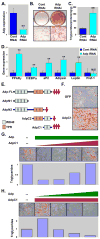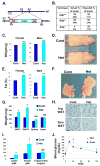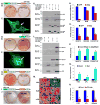Adipose is a conserved dosage-sensitive antiobesity gene
- PMID: 17767906
- PMCID: PMC2587167
- DOI: 10.1016/j.cmet.2007.08.001
Adipose is a conserved dosage-sensitive antiobesity gene
Abstract
Adipose (Adp) is an evolutionarily conserved gene isolated from naturally occurring obese flies homozygous for an adp mutation. Here we show that the anti-obesity function of Adp (worm Y73E7A.9, fly adp, and murine Wdtc1) is conserved from worms to mammals. Further, Adp appears to inhibit fat formation in a dosage-sensitive manner. Adp heterozygous flies and Adp heterozygous mutant mice are obese and insulin resistant, as are mice that express a dominant negative form of Adp in fat cells. Conversely, fat-restricted Adp transgenic mice are lean and display improved metabolic profiles. A transient transgenic increase in Adp activity in adult fly fat tissues reduces fat accumulation, indicating therapeutic potential. ADP may elicit these anti-adipogenic functions by regulating chromatin dynamics and gene transcription, as it binds both histones and HDAC3 and inhibits PPARgamma activity. Thus Adp appears to be involved in an ancient pathway that regulates fat accumulation.
Figures







Similar articles
-
Remarkable Evolutionary Conservation of Antiobesity ADIPOSE/WDTC1 Homologs in Animals and Plants.Genetics. 2017 Sep;207(1):153-162. doi: 10.1534/genetics.116.198382. Epub 2017 Jun 29. Genetics. 2017. PMID: 28663238 Free PMC article.
-
Absence of effects of Sir2 overexpression on lifespan in C. elegans and Drosophila.Nature. 2011 Sep 21;477(7365):482-5. doi: 10.1038/nature10296. Nature. 2011. PMID: 21938067 Free PMC article.
-
Control of triglyceride storage by a WD40/TPR-domain protein.EMBO Rep. 2003 May;4(5):511-6. doi: 10.1038/sj.embor.embor837. EMBO Rep. 2003. PMID: 12717455 Free PMC article.
-
An overview of the insulin signaling pathway in model organisms Drosophila melanogaster and Caenorhabditis elegans.Peptides. 2021 Nov;145:170640. doi: 10.1016/j.peptides.2021.170640. Epub 2021 Aug 24. Peptides. 2021. PMID: 34450203 Review.
-
The genetics of hiding the corpse: engulfment and degradation of apoptotic cells in C. elegans and D. melanogaster.Curr Top Dev Biol. 2004;63:91-143. doi: 10.1016/S0070-2153(04)63004-3. Curr Top Dev Biol. 2004. PMID: 15536015 Review. No abstract available.
Cited by
-
A metabolomic strategy defines the regulation of lipid content and global metabolism by Δ9 desaturases in Caenorhabditis elegans.BMC Genomics. 2012 Jan 20;13:36. doi: 10.1186/1471-2164-13-36. BMC Genomics. 2012. PMID: 22264337 Free PMC article.
-
Insect Models in Nutrition Research.Biomolecules. 2022 Nov 11;12(11):1668. doi: 10.3390/biom12111668. Biomolecules. 2022. PMID: 36421682 Free PMC article. Review.
-
Increasing variability of body mass and health correlates in Swiss conscripts, a possible role of relaxed natural selection?Evol Med Public Health. 2018 Apr 28;2018(1):116-126. doi: 10.1093/emph/eoy012. eCollection 2018. Evol Med Public Health. 2018. PMID: 29942512 Free PMC article.
-
Regulation of C. elegans fat uptake and storage by acyl-CoA synthase-3 is dependent on NR5A family nuclear hormone receptor nhr-25.Cell Metab. 2010 Oct 6;12(4):398-410. doi: 10.1016/j.cmet.2010.08.013. Cell Metab. 2010. PMID: 20889131 Free PMC article.
-
Epigenetic codes of PPARγ in metabolic disease.FEBS Lett. 2011 Jul 7;585(13):2121-8. doi: 10.1016/j.febslet.2011.05.007. Epub 2011 May 19. FEBS Lett. 2011. PMID: 21605560 Free PMC article. Review.
References
-
- Ashrafi K, Chang FY, Watts JL, Fraser AG, Kamath RS, Ahringer J, Ruvkun G. Genome-wide RNAi analysis of Caenorhabditis elegans fat regulatory genes. Nature. 2003;421:268–272. - PubMed
-
- Blatch GL, Lassle M. The tetratricopeptide repeat: a structural motif mediating protein-protein interactions. Bioessays. 1999;21:932–939. - PubMed
-
- Bluher M, Kahn BB, Kahn CR. Extended longevity in mice lacking the insulin receptor in adipose tissue. Science. 2003;299:572–574. - PubMed
-
- Campbell P, Dhand R. Obesity. Nature. 2000;404:631–671.
-
- Cerna D, Wilson DK. The structure of Sif2p, a WD repeat protein functioning in the SET3 corepressor complex. J Mol Biol. 2005;351:923–935. - PubMed
Publication types
MeSH terms
Substances
Grants and funding
LinkOut - more resources
Full Text Sources
Other Literature Sources
Medical
Molecular Biology Databases

